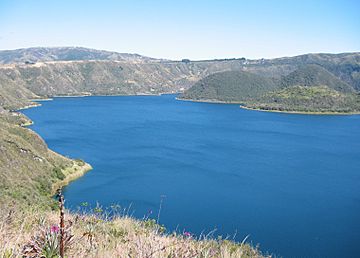Cuicocha facts for kids
Quick facts for kids Cuicocha |
|
|---|---|

The Cuicocha crater lake seen from the caldera rim.
|
|
| Highest point | |
| Elevation | 3,246 m (10,650 ft) |
| Geography | |
| Location | Imbabura Province, Ecuador |
| Parent range | Cordillera Occidental, Andes |
| Geology | |
| Mountain type | Inactive caldera |
| Last eruption | 650 CE (?) |
Cuicocha (pronounced Kwee-KOH-cha) is a beautiful crater lake in Ecuador. It is about 3 kilometers (1.9 miles) wide. You can find it at the base of the Cotacachi Volcano in the Andes mountains.
Its name comes from the Kichwa language. It means "Lake of Guinea Pigs" or "Rainbow Lake." The biggest island in the lake looks like a guinea pig! Guinea pigs are important animals in Ecuador. They are easy to raise and provide a good source of food for people living high in the mountains.
Contents
How Cuicocha Was Formed
Cuicocha is actually a caldera. This is a large bowl-shaped hollow that forms after a volcano erupts and collapses. Cuicocha's caldera was created by a huge eruption about 3,100 years ago. This eruption sent out a lot of hot ash and rock. It covered the nearby area with up to 20 centimeters (8 inches) of volcanic ash.
The volcano continued to be active until about 650 CE. Along with other nearby volcanoes, Cuicocha helped create the rich, fertile soil in the Otavalo Valley. This soil is great for farming.
Exploring Cuicocha Lake
The lake itself is inside the Cuicocha caldera. It has two steep, forested islands. These islands are called Yerovi (the smaller one) and Teodoro Wolf (the larger one). People are not allowed to visit these islands.
The edge of the caldera is very steep. The lake is 200 meters (656 feet) deep at its deepest point. The water is very alkaline, which means it has a high pH level. Because of this, not many plants or animals can live in the lake itself. There is also no known river or stream flowing out of the lake.
Wildlife Around the Lake
Even though the lake has little life, the islands inside the caldera support some wildlife. The most notable animal is the silvery grebe. This bird lives among the reeds around the islands. It eats small fish, frogs, crayfish, tiny water snakes, seeds, and insects.
The silvery grebe lives in the Andes mountains. However, not much is known about this specific type of bird. In 1974, a count was done at Cuicocha. They found 44 silvery grebes living there.
Cultural Importance and Protection
Cuicocha marks the southern end of the Cotacachi-Cayapas Ecological Reserve. This is a protected area for nature.
Every summer, during the second day of Inti Raymi (the Sun Festival), local indigenous shamans use Cuicocha. They take a bath in the lake for ritual cleansing and purification. This is an important spiritual tradition.
A Special Geological Site
The International Union of Geological Sciences (IUGS) recognized the Cotacachi-Cuicocha volcanic area as a special 'geological heritage site'. This happened in October 2022. It was chosen because it is a 'volcanic complex with a spectacular 3km wide active volcanic caldera'. It also has many records of powerful past eruptions.
An IUGS Geological Heritage Site is a very important place. It has geological features or processes that are scientifically important worldwide. These sites are used as references or have greatly helped the study of geology over time.
See also
 In Spanish: Cuicocha para niños
In Spanish: Cuicocha para niños
- List of volcanoes in Ecuador
- The best tour to Cuicocha Lagoon


